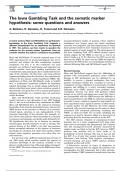Update TRENDS in Cognitive Sciences Vol.9 No.4 April 2005
Research Focus
The Iowa Gambling Task and the somatic marker
hypothesis: some questions and answers
A. Bechara, H. Damasio, D. Tranel and A.R. Damasio
Department of Neurology (Division of Cognitive Neuroscience), University of Iowa College of Medicine, Iowa, USA
A recent study by Maia and McClelland on participants’ neuropsychological studies of patients whose cognitive
knowledge in the Iowa Gambling Task suggests a intelligence was largely intact but whose emotional
different interpretation for an experiment we reported reactions were impaired, and from experiments in which
in 1997. The authors use their results to question the those patients failed to show emotional reactions to the
evidence for the somatic marker hypothesis. Here we implied content of social stimuli [4]. The development of
consider whether the authors’ conclusions are justified. the Iowa Gambling Task (IGT) offered further experi-
mental support for the SMH, in ours [2] as well as in
Maia and McClelland [1] recently repeated part of our others’ hands (e.g. [5–9]). However, the IGT was not the
1997 experiment [2] (in normal participants but not in basis for the SMH, let alone was the SMH developed to
patients) and without the skin conductance response account for the IGT results, as is surprisingly stated in an
component (see Box 1) in two conditions: one used editorial following Maia and McClelland’s report [10].
precisely our method of questioning and replicated our
results; another used more probing questioning and
revealed that most participants have considerable knowl- Reversal learning
edge of the situation. On this basis, and using selected Maia and McClelland suggest that the difficulties of
supporting findings from the literature, they question the patients with ventromedial prefrontal cortex (VMPC)
evidence for the somatic marker hypothesis (SMH). The damage in IGT performance can be explained by an
significance of Maia and McClelland’s study is twofold: inability to reverse a learned contingency that such
first, it undermines traditional methods for identifyng patients sometimes exhibit [11]. Learning to reverse a
implicit knowledge, that is, simply asking individuals to contingency involves inhibition of a previously rewarded
response and shifting to a newly rewarded response.
declare what they know about a given situation; second, it
Although some VMPC patients have problems with
demonstrates yet again that even in normal participants,
contingency reversal (e.g. those with posterior orbital
adequate knowledge of a situation does not guarantee
lesions, as we [12,13] and others have noted [14]), this is
correct decisions.
not incompatible with the SMH because the difficulty is
Maia and McClelland’s study provides fascinating
itself accounted for by the SMH. In order for contingency
results relevant to any discussion of our 1997 findings
reversals to occur, a signal is required (a ‘stop’ signal); we
(Box 1), but we do not believe they undermine the SMH.
have argued that such a signal is emotive, in other words,
Maia and McClelland focus on the amount of conscious
a somatic marker [15,16]. Moreover, the brain regions
knowledge of the situation participants have, whereas the
associated with reversal learning are the same as those
SMH focuses on the presence or absence of an emotion-
associated with emotional processing, including the
related signal, conscious or not, independently of the VMPC, as shown by Rolls [17]. In short, inhibiting the
conscious knowledge of the situation. For example, we response is in itself a ‘decision’, albeit at a lower level of
have shown that patients whose knowledge of a situation processing than the decisions carried out in the IGT.
is conscious and adequate can decide quite deficiently [3]. The IGT contains elements of contingency-reversal
We hypothesize that they do so because an emotion- learning, but at a more complicated level than other
related signal, the SM (conscious or not) is missing. The tasks used to investigate the phenomenon [18]. Patients
central feature of the SMH is not that non-conscious who fail contingency-reversal decisions measured by
biases accomplish decisions in the absence of conscious simpler tasks are likely to fail the IGT; however, VMPC
knowledge of a situation, but rather that emotion-related patients who perform well in those tasks or in
signals assist cognitive processes even when they are probabilistic reversal learning [18], may or may not fail
non-conscious. the IGT. It is of note that normal performance in the
It is not clear why a different interpretation for part of Wisconsin Card Sorting Task requires contingency-
our 1997 study, which revolves around the amount of reversal learning and many VMPC patients perform
conscious knowledge of the situation available to the excellently in this task [3,19].
players, would undercut ‘one of the main pillars of support’ A behaviorist account in terms of adaptation to
for the SMH. The main evidence for the SMH comes from contingency reversals does not explain why patients who
Corresponding author: Bechara, A. (antoine-bechara@uiowa.edu). conceptualize the IGT consciously fail to play advanta-
geously. Besides, VMPC patients do switch away from the
www.sciencedirect.com





